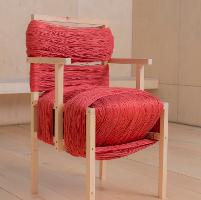Does the design of everyday things inadvertently reinforce stereotypes around ageing? Does the imagery in today media-rich environment put up barriers around older people rather than reducing stigma?
These are questions that the youth-oriented creative industries – from product design and photography to furniture, branding and advertising – have debated for a long time without reaching any real conclusions. Adept as they may be at creating and defining identity, these sectors have sometimes struggled to adapt to changing demographics.
I raise the issue again upon review of an international design project called 19 Chairs, which is admirable in many ways but also revealing in what it says about age. During the Covid-19 crisis, brothers Tom and Will Butterfield designed a unique wooden chair every day over 19 days of lockdown and then shipped them to 19 creatives in 19 different locations around the world with a brief to ‘reinvent, reimagine or redesign your chair with an older person in mind’. The initiative was aimed at supporting two charities, Age UK and Resourcing Racial Justice.
The result of the exercise was a wonderfully eclectic collection of chair ideas and embellishments which ranged from Tom Dixon’s aspirational foil-covered ‘Seat for Buzz Aldrin’ to Benjamin Edgar’s blue-painted ‘Tired, but Quite Optimistic’ chair with its drooping seat profile. What struck me was the way several of the designers immediately associated ageing with exhaustion. Some pieces hinted at rebirth and renewal – but not before reaching a point of depleted energy requiring a padded retreat from the world.
The way that everyday products and images speak to us about ageing is something that concerns researcher and activist Georgina Lee, who is working with the Royal College of Art and the Oxford Institute of Population Ageing to create a community of practice around the Design Age Institute, a new initiative to create more age-friendly products and services.
As part of the Design Age Institute, Lee has launched a website, This Age Thing, to tell positive stories about ageing to counteract the stereotypes that are out here. She accepts that ageing is a complicated issue and won’t hold back from identifying the challenges – but storytelling is essential to sharing experiences.
Two projects showcased on This Age Thing platform reflect her thinking. The first is a simple, smart, hands-free shoe from Nike, the Nike Go FlyEase, which is a great example of inclusive design. Lee explains: ‘Whether you are a parent with toddlers in your arms, or on the way back from the shops with heavy bags, or having trouble getting down to tie laces because of your arthritis, or for me, trying to get shoes on and navigate the dog, these shoes are just amazing.’
The second project is a collection of images, The Body of Elders, by the renowned photographer Jade Beal that celebrates beauty in older age groups. One image of Gerry, 75, and Darwin, 70, reached two million people in just a few days when posted online. Projects like these challenge our perceptions of ageing.
Lee even includes a chair on This Age Thing – except it’s a talking chair, a robot chair, that can provide care in the home. The message is clear: let’s use design and image-making to reinvent ageing, not reinforce the stereotypes that drag us down.


About the Author
Jeremy Myerson is Helen Hamlyn Professor of Design at the Royal College of Art and an Honorary Professorial Fellow at the Oxford Institute of Population Ageing.
Opinions of the blogger is their own and not endorsed by the Institute
Comments Welcome: We welcome your comments on this or any of the Institute's blog posts. Please feel free to email comments to be posted on your behalf to administrator@ageing.ox.ac.uk or use the Disqus facility linked below.













